Traditional boats- building and use
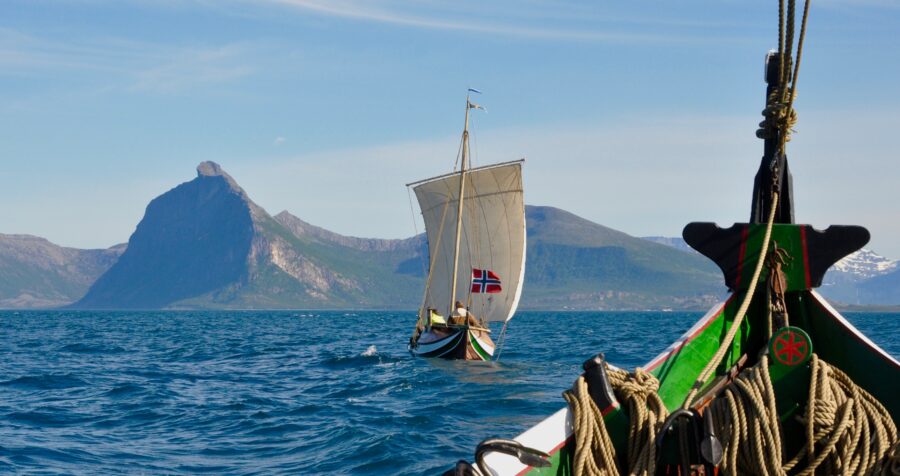
Background
(Main picture: Ulf Mikalsen)
Traditional open wooden boats have a long history in Norway, but safeguarding measures are needed to ensure the future building and use of these boats.
The Norwegian Coastal Federation (Forbundet KYSTEN) received in 2018 a generous grant from the Savings Bank Foundation DNB (Sparebankstiftelsen DNB) for the project “Traditional boats – building and use”. The grant was divided between 28 different projects all over Norway. The idea was to ensure the safeguarding of the mostly intangible knowledge about the building of the boats and the skills needed to use them. The projects therefore had a focus on knowledge transfer and on new, younger, user groups.
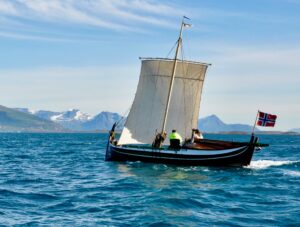
Sailing a traditional Nordland boat demands a variety of skills. Photo: Ulf Mikalsen
Safeguarding through use
In the project 42 boats was built. During the building important action-borne knowledge was passed on. The boats were then given to groups and associations in the community as well as museum, to ensure the continued use of the boats, especially by the younger generation.
Nationwide projects
The projects were carried out all over Norway, from Porsanger in the north to Kristiansand in the south. The boat types in Norway vary according to the use and the conditions in the area where the boats are built and used. The project had a wide scope, from the inland boats from Drammen and Gausdal, the boats created in the fiord landscapes of Nordfjord and Hardanger, to the boats made for fishing in open sea, like the larger Nordland boats traditionally made for the Lofoten fisheries.
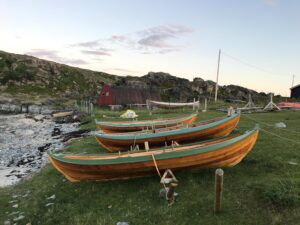
Boats from Porsanger. Photo: Mearrasiida
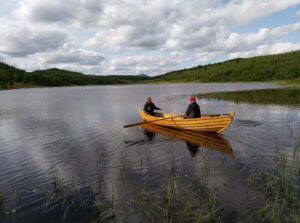
Rowing a so called “Lauvålibåt” from Gausdal, in the Inland region of Norway. Photo: Gausdal Folk Art and Craft Association.
How it was done
The project provided funding that boat builders, associations, museums etc. could apply for. The following criteria were the basis for the projects:
- The funding must go to projects concerning the building of open traditional wooden boats, with a local or regional connection.
- An apprentice, or another method for transferring knowledge and skills, shall be part of the building project.
- The boats shall be linked to concrete plans for future use by the wider community.
- The projects must aim for long-term activity, through active use and transfer of knowledge and skills.
- The project must have a plan for the dissemination of the project and the tradition.
- Projects concerning local communities with few remaining tradition bearers in the craft will be emphasized.
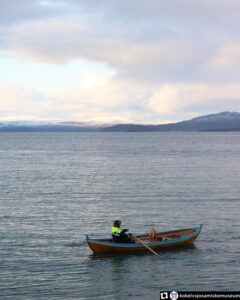
Rowing the “spissbåt” from Porsanger. Photo: RiddoDuottarMuseat
Examples of projects
The Nordfjord boat.
One exampel of the projects was “Nordfjordbåtprosjektet”. The Nordfjord boat is a type of boat that has been built and used for many centuries in the fiord landscape in Nordfjord in the western part of Norway. Now there is only one tradition bearer who practice the building of this boat: Kristen Arnestad, who has combined being a farmer and building boats. A young man, Andreas Mardal, had for a long time wanted to learn the tradition. Mardal is an experienced craftsman and has also built some boats. But he wanted to learn more and further master the tradition. The project was done over 2 years, and 3 boats were built.
The first boat was made by the master and tradition bearer Arnestad, with Mardal following the process as an apprentice and participating in some in the building. The second boat was built together by the two craftsmen. The third boat was made by Mardal, with the master and tradition bearer now as a mentor and supervisor.
All three boats were given away to the local branch of KYSTEN. They have organized training in the use of the boats, both rowing and sailing. Both boat builders have been part of this by giving advise and participating in the testing of the boats in practical use. This way hands-on experience is gained for future projects.
The Church boat of Hardanger
In the Hardanger fiord in western Norway quite a large number of traditional boats have been preserved in the boathouses along the fiord. The funding made it possible to built a copy of a 150 year old Kyrkjebåt or Church boat. Boatbuilder Peter Helland- Hansen and apprentice Arne Eriksen built the boat at Hardanger Maritime Center and Hardanger Folkehøyskole( Folk high school) is one of the institutions using the boat, that got the name “Signe”.
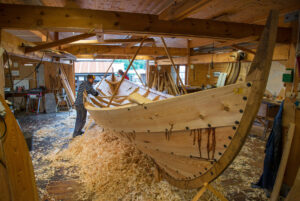
Building the Church boat. Photo: Lars Arvid Oma
The boat is a cultural icon along the fiord, made immortal by the famous painting Bridal Procession on the Hardangerfjord by Hans Gude and Adolph Tidemand from 1848. Now this rare sight is still possible to experience along the fiord.
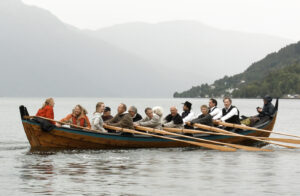
A large Kyrkjebåt, “Church Boat” was built in Hardanger during the project. Rowing “Signe” in the Hardanger fiord. Photo: Silje Ensby
The Boat Builders. Reaching a wider audience
For further dissemination to a wider audience it was decided to contact film producers to make a film of the craft of boat building in Norway.
The filmmakers Oslo Filmkompani visited the boat builder Ulf Mikalsen and his apprentice Stephanie Hein on Kjerringøy, Kristen Arnestad and his apprentice Andreas Mardal in Gloppen, Jonathan Grimstad and Svein Walvick at Bragdøya and in Mandal. The film photographers have been “fly on the wall” in the workshops. They have also interviewed old and new boat builders about the craft, about the transfer of the intangible knowledge, and about the future of the tradition.
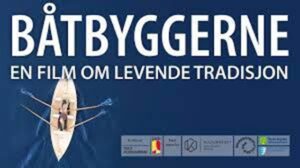
Watch the film here !
The future:
The safeguarding method, with a combined focus on both knowledge transfer and the continued use of the finished boats, has generated similar projects built on the same methodology:
KYSTEN has received a new grant from The Savings Bank Foundation DNB ( Sparebankstiftelsen DNB) to further secure the knowledge of the building and use of traditional boats. 12 million Norwegian kroner is given to the second part of the project. In addition, the foundation has given 10.5 million to the building and use of boat houses (Naust in Norwegian) and buildings by the sea connected with fishing and maritime activity (Sjøhus in Norwegian). This last project is being designed in the same way as the traditional boats-project. The buildings will be restored, using traditional methods. Once restored they will be made available for use, particularly by the younger generation. Future activities will include traditional crafts, outdoor skills and the buildings as base for storage and use of the boats that are being build.
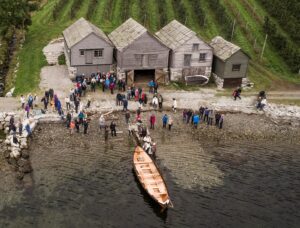
It is important to see the whole cultural environment surrounding the boats and their use: the connection between the boats , the landing sites (Norwegian: Stø) and the boat houses (Norwegian: Naust). And of course the intangible knowledge involved in their use. Here an areal view of a church boat and several boat houses in Hardanger fiord, Western Norway. Photo: Arvid Aga
There is an urgent need to safeguard and keep knowledge and skills in the building and use of traditional wooden boats alive in the years to come. There is also great need to recruit younger boat builders and also to have a sufficient market for the building of new boats.
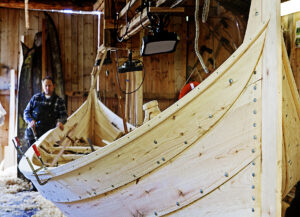
Building a Nordland boat (Nordlandsbåt) from the Rana area, for use at Grøtavær Camp School on the island of Grytøya, Troms, Northern Norway. This boat has four pairs of oars and is called “firroring” in Norwegian. Pictured is boat builder Ola Fjelltun.
Photo: KASAVI / Arne Terje Sæther
The project Traditional boats-building and use has made possible the building and use of a wide variety of boat types, giving the practitioners of the craft important new skills and broader training. Non -profit organizations, museums and schools that will use these boats in the future do not normally have the funding for ordering such traditional boats.
The funding has made it possible to contribute to the safeguarding of the tradition of the open wooden boat and clinker boat in Norway, both to the boat building craft and the skills involved in their use.
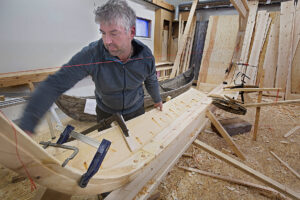
New projects are already well under way in 2023: Building a copy of a boat from Neiden (Skolt Sami: Njauddâm, Northern Sami: Njávdán Inari Sami: Njiävđám, Finnish: Näätämö) in eastern Finnmark, Northern Norway.
The original boat was specifically designed for use on the Neiden river, and the plan is that the new boat will be available for public use on the river, through Ä’vv Skolt Sámi museum. Boatbuilder is Arne Terje Sæther with Ben Arne Sotkajærvi (pictured here). Photo: KASAVI/ Arne Terje Sæther
